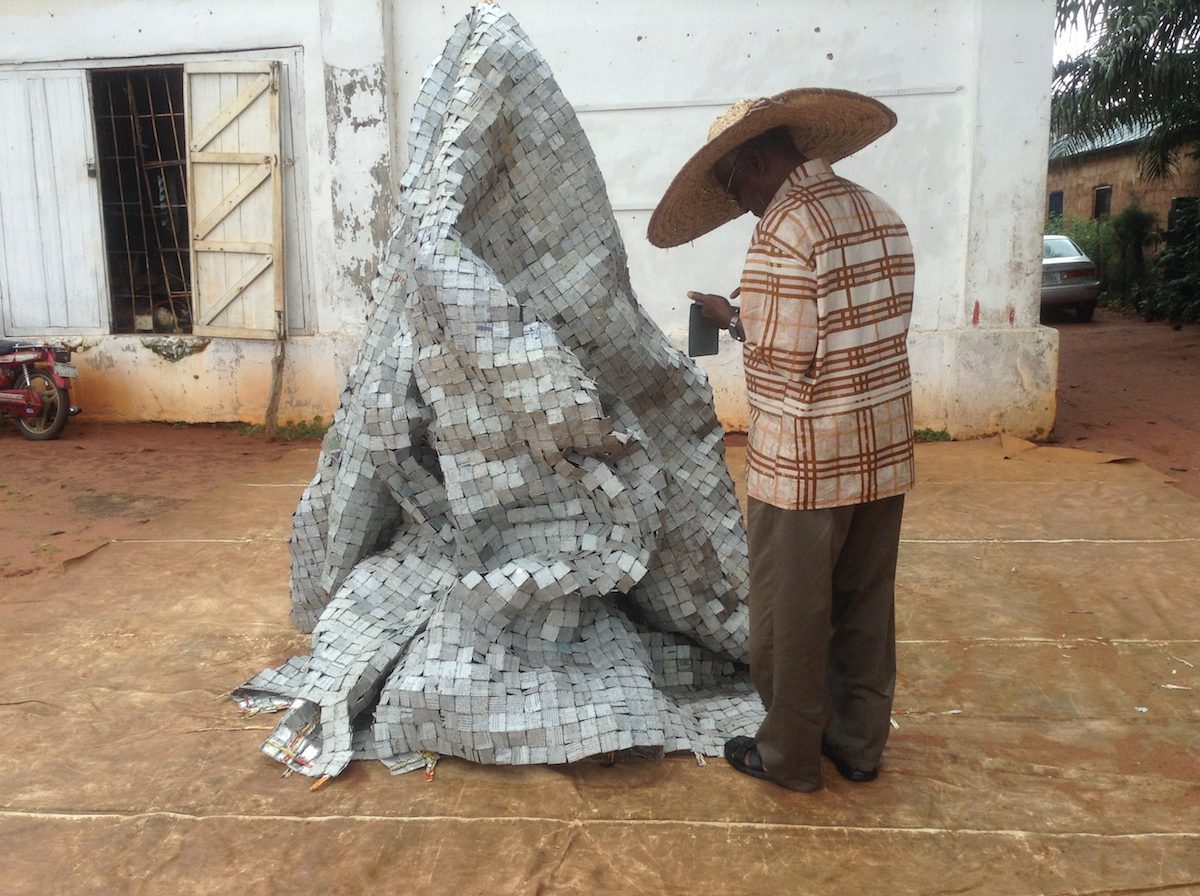World famous artist El Anatsui invited an eclectic crowd to his Nigerian studio, where he talked about materiality, artistic currents and personal developments

Prof. Anatsui in front of his studio with a work
Okwui Enwezor once described him as “probably the most important living African artist.” After several awards and recognitions across continents, Ghana born and Nigerian based sculptor El Anatsui came home to Nsukka this summer. Between June 24th and 27th 2015, an interdisciplinary African Arts Conference was held in honour of him and his contemporary, Obiora Udechukwu by the University of Nigeria, where Anatsui had taught Sculpture for 36 years. Part of the closing ceremony was a visit to his studio where he talked about materiality and historicity.
While explaining the studio structures and processes to groups of participants, El Anatsui welcomed artists, cultural entrepreneurs, academics and the media from different countries. Walking past uncompleted works, scraps, and finished pieces in various stages of packaging, he talked about his methods of working with “apparently useless materials.” He explained that, “the more useless they seem, the more appealing they are to me, because useless things relay interesting messages when they are turned around.”
After migrating to Nigeria in late 1974, he got appointed at the department of Fine and Applied Arts the following year. Since then he has relentlessly investigated his artistic approach in relation to various materials. Early on Anatsui began to see the potentiality in detritus, especially of metals, which he describes as “rich in historicity”. His quest for unique and peculiar perspectives has become an amalgam of his global and local visions. The first metal sheets that he worked with were used graters recovered from Cassava processing machines for making garri – a staple food in West Africa. “Someone had used it to fence a tree from being destroyed. It looked rusty and I also discovered that I could see through it, the part of the tree it fenced was partially visible. I saw transparency in it; I had found an expressive medium.”
On identifying the medium, his experimental energy sustained the search for where he could source the desired quantity. “It was at Coal Camp, in the nearby city of Enugu fifty kilometers away, that he found it.
Anatsui’s stylistic migration from one medium to the next was yet again a chance discovery – a bag of bottle tops that he found in the late nineties. The medium has since yielded a great number of works and has become his signature in the last decade. “When I started with the bottle tops, I thought it was going to be a very short run. At the time, I didn’t think it had much potential, but as I kept working on, I began to discover new things about it”
Pondering about his work with various media, he said: “It is not about looking for just shapes or materials but for shapes which relate material and the work together.” Like he stated in a recent interview: “When somebody says the tire is my medium, I expect to recognize its essence. Even if it is shredded, it should still have elements of its identity so that people can connect to its qualities such as movement, travel and distance.”
Like his contemporary and fellow artist Obiora Udechuckwu, El Anatsui not only draws his materials from his surroundings, he also draws energy from his culture. Anatsui excels in using local idioms and materials to create his conceptual works. He has used elements from Uli (wall and body paintings primarily practiced by Igbo women of Southeastern Nigeria) and Nsibidi iconography of neighboring Efik and parts of Igboland. Like Udechuckwu, he has also found poetry an authentic medium of expression. Yet, while Udechukwu is a poet with publications and prizes to his credit, El Anatsui uses and makes allusions to poetry in his works.
This phenomenality is vividly seen in the titling of a number of his sculptures, which sometimes go beyond mere description but assume poetic significance; a dimension that provides viewers with alternative routes of communication and a channel to appreciate the physical work before them. “You know the Nsukka bug”, he says. “Associating with poets and writers like Obiora Udechukwu, Uche Okeke and the rest, you start writing poetry without knowing it”.
As the studio talk came to an end, the participants began to break into small groups, the cameras began to click and the chit chats centered on the successes of the conference. There was great consent about the fact that the contemporary currents that Anatsui had embraced early in his career, have been entrenched in the Nsukka art school, just as they swept across the world. Anatsui’s sculptures have addressed varied cultural and social themes drawn from his native Ghana and the social environment in Nigeria where he has lived and worked for decades. So, people talked about how Africa is not left behind in this movement of new currents.
Agwu Enekwachi is a Sculptor, Art teacher and freelance writer. He is currently an MFA student in the University of Nigeria, Nsukka. He participated in the Culture Journalism Workshop organized by Contemporary And in Lagos, Nigeria.
More Editorial